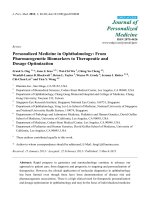Pediatric emergency medicine trisk 2260 2260
Bạn đang xem bản rút gọn của tài liệu. Xem và tải ngay bản đầy đủ của tài liệu tại đây (166.02 KB, 1 trang )
CHAPTER 94 ■ INFECTIOUS DISEASE EMERGENCIES
ANDREA T. CRUZ
GOALS OF EMERGENCY CARE
Fever is one of the most common presenting complaints for children seen in the emergency department (ED). ED
physicians face the challenge of differentiating potentially life-, limb-, or sensory-threatening causes of infection
from the vast majority of children with febrile illnesses that will spontaneously resolve without intervention. For
infectious disease (ID) emergencies, the clinical evaluation should focus upon prompt recognition of potentially
serious conditions. Evidence-based diagnostic strategies can facilitate care and avoid unnecessary evaluations of
otherwise well-appearing children.
RELATED CHAPTERS
Signs and Symptoms
Diarrhea: Chapter 23
Fever: Chapter 31
Lymphadenopathy: Chapter 47
Neck Mass: Chapter 48
Oral Lesions: Chapter 52
Septic-Appearing Infant: Chapter 73
Sore Throat: Chapter 74
Tachycardia: Chapter 77
Medical, Surgical, and Trauma Emergencies
Cardiac Emergencies: Chapter 86
Gastrointestinal Emergencies: Chapter 91
Gynecology Emergencies: Chapter 92
Oncologic Emergencies: Chapter 98
BACTEREMIA AND SEPSIS
CLINICAL PEARLS AND PITFALLS
It can be difficult to differentiate among children with uncomplicated viral infections and occult
bacteremia.
With reduction in vaccine-preventable diseases, most positive blood cultures are false positive with
contaminants.
Evidence-based guidelines can optimize management in the young febrile child.
Current Evidence
The epidemiology of pediatric bacteremia has changed dramatically over the last three decades due to widespread
use of the 13-valent pneumococcal conjugate and Haemophilus influenzae type B (Hib) vaccines. The most
common isolates now causing bacteremia are listed in Table 94.1 . While rates of pneumococcal bacteremia have
declined in the post-pneumococcal conjugate vaccine era, Streptococcus pneumoniae still comprises most cases of
bacteremia, along with Staphylococcus aureus, Salmonella, group A streptococcus (GAS), and meningococcus;
group B streptococcus (GBS) and gram-negative rods remain the most common causes of bacteremia and sepsis in
neonates and young infants. In some studies, contaminants are up to sevenfold more common than true pathogens.
As a consequence, use of evidence-based algorithms in the approach to the febrile child (Chapter 31 Fever ) can
reduce unnecessary evaluation and optimize treatment of the well-appearing child.









